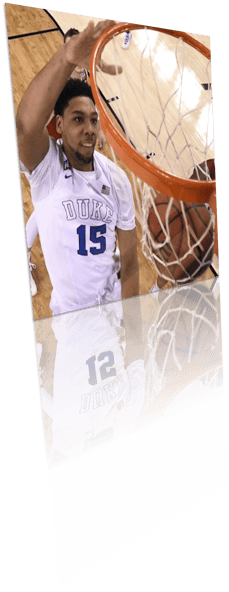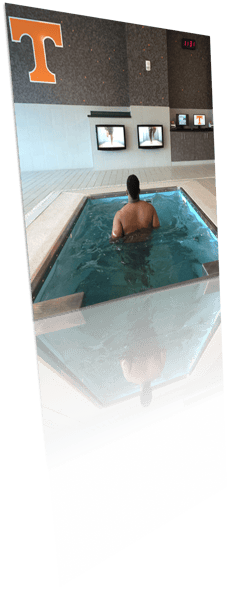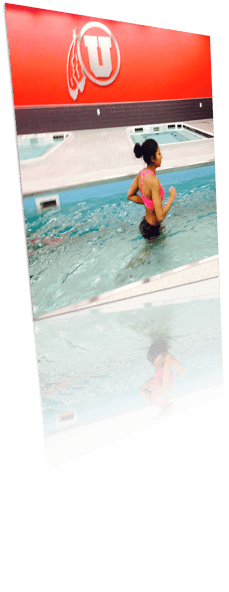Recognizing those who achieve exceptional rehabilitation results through the use of advanced water therapy.
Sports fans everywhere love a good comeback story. The spirit of the game is epitomized by an athlete's triumph just months after recovering from a devastating injury. Behind these great comeback stories are the athletic trainers and medical staff who also sacrificed to ensure these athletes and teams would reach their goals.
The 2015 Excellence in Aquatics Award will recognize professionals who, despite all odds, garnered superior rehabilitation results through innovative, and sometimes unconventional, methods. Eligible pioneers rely on aquatics as a medium to help achieve exceptional results.
Read the nominees below and vote today! You can vote one time per day until June 17, 2015 at 11:59pm EDT to support your top pick. The winner of the 2015 Excellence in Aquatics Award (SMED) will be announced in the HydroWorx Booth, #1723, at the National Athletic Trainers' Association's Annual Symposium in St. Louis, MO on Thursday June 25th. Spread the word on twitter and facebook with #ExcellenceInAquatics.
AND THE NOMINEES (in alphabetical order) ARE…..

On February 18, 2015 a freshman star basketball player suffered a moderate/severe left lateral ankle sprain during a game. After completing the game, he was unable to bear any weight, was given crutches and a short walking boot.
This athlete was very familiar with the HydroWorx pool, as he had used it two to three times per week throughout the season for extra conditioning. Two days post-injury, the athlete used the pool to focus on generating early range of motion with various exercises along with underwater treadmill walking to keep his gait as normalized as possible.
Using the pool this early post-injury contributed to his faster than anticipated return. The typical recovery time frame for a severe ankle sprain can be anywhere from 4-8 weeks. The athletic training staff at Duke University were anticipating that this athlete's recovery time frame would be between 10 days to 3 weeks. He only missed one game, which was 3 days post-injury. One week after his ankle sprain, on February 25, 2015, he returned not only to play, but to dominate. In the game against Virginia Tech, which went into over time, he played 37 of 45 minutes, was 13 for 18 from the field and tallied 30 points, 9 rebounds and 1 block.
Thanks to his magnificent performance, the Blue Devils went on to win that game 91-86 in overtime. Not only did they win that game, thanks in part to this athlete’s 90 points in the NCAA Tournament, Duke went on to win the NCAA Men's Division I Basketball Championship in 2015! Additionally, he was named the USBWA National Freshmen of the Year, first ever freshman ACC Player of the Year and unanimous 2015 NCAA Men's Basketball All-American first-team selection.

Winner Will Be Announced:
Thursday, June 25th
at NATA in St. Louis, MO
HydroWorx Booth #1723
Voting has now ended. Please stay tuned to find out the winner!
University of Tennessee’s Sports Medicine Staff for Shattering the Rehab Time Frame Expectations of Freshman Lineman

On July 6, 2014 this 18 year old freshman football lineman was involved in a motor vehicle accident on his way back to school for pre-season practices. He was transported to the hospital via helicopter where he was diagnosed with a left leg Tibia/Fibula closed fracture, shaft fracture and compartment syndrome.
The 6’4”, 379lb. lineman underwent surgery the following day, which resulted in multiple incisions, 2 screws, 2 distal locks and a long road ahead. Due to the severity of injuries, the orthopedic surgeon’s estimate for return to play was 12 months.
From weeks 4 to 10, the University of Tennessee’s athletic training staff focused on manual exercises, wound management and increasing range of motion. The athlete’s incisions continued to drain persistently into week 10 which delayed its closure.
The athlete’s excessive weight, the severity of injury and post-operative complications of compartment syndrome created a need for progressive low-impact cardiovascular and strength training. This was achieved by multiple sessions per week in their HydroWorx pool.
The training staff had the athlete in the pool from weeks 11 to 26. By the second week of being in the pool, the lineman had already progressed to light pool jogging and backpedaling on the underwater treadmill. The following week, the staff began to lower the depth of the water to gradually increase weight bearing. He was back in the pool in week 31, following the surgery to remove the lock screws, for reduced weight bearing conditioning, sprinting, hopping and bounding.
At week 38 he returned to practice for the first day of the spring season- returning to play 14 weeks earlier than projected. All of the training staff’s expectations were exceeded. They anticipated limiting repetitions during spring football and having to rest him if any of the activity was too strenuous. But he participated in all 15 spring practices in March and April 2015 with minimal complaints or restrictions.
University of Utah for the Recovery of Gymnast’s Torn Achilles Tendon to Achieve Personal High Scores

On January 11, 2014 this University of Utah Gymnast ruptured her Achilles tendon during a floor routine in the first meet of the season. That was the first time she was set to compete in all 4 events in her entire career. She underwent surgery to repair the tendon the following week and was put into a heel lift to prevent any stretching of the tendon.
Athletic trainer Katherine Lorens had the athlete in their HydroWorx pool as soon as she could. She was swimming against the jets, working on balance, gait and sprinting during all of her aquatic therapy sessions. Her pool workouts consisted of a warm-up with the jets at 35% followed by 5-7 sprints of 1 minute each with the jets at 70%. Being able to start these exercises earlier allowed for more development of the fast twitch muscles and the ability to gain back her full power. Lorens continued to have the athlete in the pool even after she was able to run on land to limit the pounding that tendon took and avoid tendonitis.
She was able to start training with her teammates in the fall just 7 months after her injury and hasn’t had any problems from the surgery at all. She was fully back to her pre-surgery condition just 9 months post-op and was able to compete in the entire 2015 gymnastics season. She recorded personal high scores on the uneven bars and helped her team take 2nd place at the NCAA National Championships this year. She is fully expected to compete in the all-around this coming year with the hope of once again placing in the top 3 at the NCAA Championships.
Add content here.
The 2015 Excellence in Aquatics Award (SMED) Selection Process:
This public voting page will be open until June 17, 2015 11:59pm EDT. Individuals are allowed to vote once per day. At the conclusion of the voting period, the winner of the public’s vote will count as 1 vote. The finalists will also go through a judging process by a panel of six independent judges which will each count for 1 vote for a total of 7 votes to determine the overall winner.
The winner of the 2015 Excellence in Aquatics Award (SMED) will be announced in the HydroWorx Booth, #1723, at the National Athletic Trainers' Association’s 66th Annual Meeting and Clinical Symposium in St. Louis, MO on Thursday, June 25, 2015.
The Award: